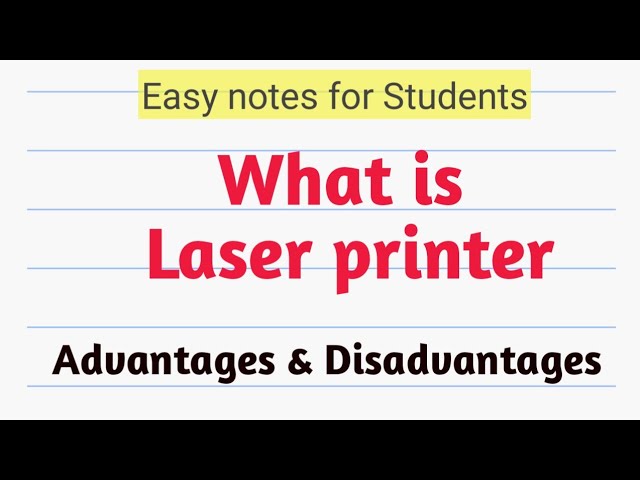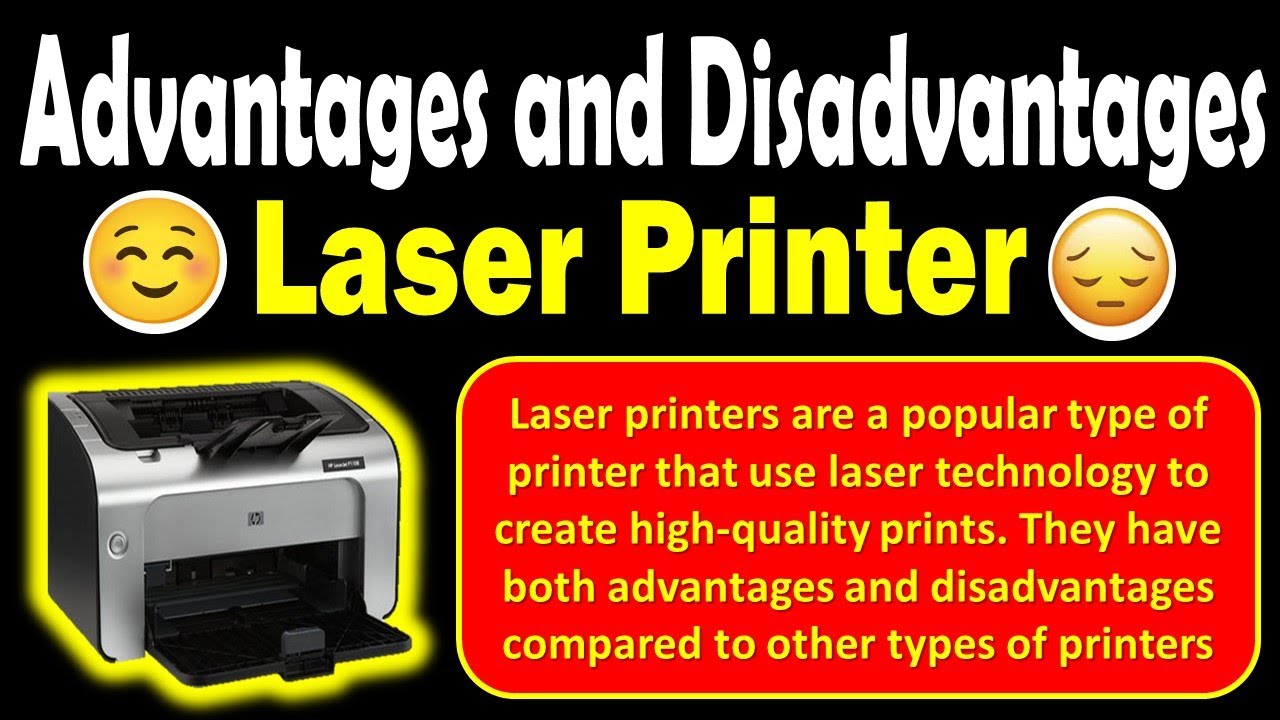An Examination of Laser Printers: Evaluating the Pros And Cons
Introduction
Digital printing has immensely revolutionized our printing landscape, making tasks quite straightforward and efficient. Spearheading this change are laser printers – known for their speed, precision, and durability. In today's article, we undertake an in-depth analysis of this technological marvel, the laser printer. We'll discern its mechanics, evaluate its pros and cons, and answer some frequently asked questions. If you're contemplating investing in one, read on to make an informed decision.
What is a Laser Printer and How Does it Work?
The emerging era of digitization acknowledges laser printers as an integral part of technological advancement. Acclaimed for their seamless performance and efficiency, laser printers manage to stand out in the wide array of printer options available. But how exactly do these machines function? Here is a simplified breakdown of their working mechanism:
1. Defining Laser Printer: Predominantly utilized for their fast-paced and high-quality output, a laser printer is a digital machine devised to produce text and graphics most effectively.
2. The Mechanism: The printer operates with a laser beam that moves back and forth on a negatively charged cylinder known as a 'drum.'
3. Emerging Image: As the drum engages with toner (a powdery substance), it sticks to the charged areas, consequently forming an image.
4. Transfer and Seal: This image is subsequently transferred onto a sheet of paper, while heat and pressure effectively seal it.
5. The Process: The process described above, from a laser beam to a printed sheet, is known as 'Electrophotography.' This intricate process exemplifies the distinct sophistication and precision of laser technology used in printing.
Understanding the working of a laser printer offers insights into its impressive speed, accuracy, and proficiency, thus assisting you in making an informed purchasing decision.
Why Are Laser Printers Considered Beneficial?
The choice of a laser printer is a popular one, cemented by several compelling advantages that cater to various printing needs. The three key advantages that vouch for their efficiency are:
- Quality and Consistency of Output
- Cost-effectiveness for Voluminous Printing
- Speed and Time Efficiency
Outstanding Quality and Consistency
A standout feature of laser printers is their ability to deliver high-quality output with unswerving consistency. They are designed to excel in producing crystal clear, sharp text and detailed graphics, establishing them as a reliable variant for both professional and personal printing purposes.
Affordability for High Volume Printing
With an initial investment that's marginally higher than its competitors, a laser printer may appear costly initially. However, its biggest selling point remains the low cost per page ratio, making it an economical choice for high volume printing in the long run. Thus, despite a higher upfront cost, it proves to be a cost-efficient selection for sustaining voluminous printing needs.
High Speed and Time Management
In addition to quality and affordability, the laser printer scores high on speed. It is capable of handling high capacity printing tasks at rapid rates, making it enormously time-efficient. Its unmatched pace not only accelerates productivity but also proves beneficial in time-critical situations. Simply put, if time is of the essence, a laser printer should be your go-to choice.
To sum up, laser printers offer numerous benefits making them a compelling choice for users. They cater to a broad spectrum of printing requisites with effectiveness, efficiency, and speed, granting improved productivity and worthwhile returns on investment.
What Are the Limitations Associated with Laser Printers?
As with any technology, laser printers come equipped with their set of imperfections. This section is dedicated to exploring some of the most prominent cons associated with these printers.
Are the Initial Costs for Laser Printers on the Higher Side?
Indeed, one prominent downside of laser printers is their steep initial price. In comparison to their counterparts such as inkjet printers, the upfront costs for laser printers are significantly higher. However, these costs can be offset in the long run, particularly for businesses with extensive print demands.
What is the Space Footprint of Laser Printers?
Laser printers are notorious for their size. They tend to be larger and heavier than other categories of printers like inkjet or dot matrix printers. This characteristic implies a greater space requirement, which can be a potential disadvantage for small offices or home setups where space is at a premium.
Is the Upkeep for Laser Printers a Complex and Costly Affair?
While laser printers are famed for their durability and long-term functionality, their upkeep is not as straightforward. Maintenance can be somewhat complex due to the technology involved, and costs associated with replacement parts (like toner cartridges) can stack up over time. However, their ability to provide long-term reliability and consistent high-quality output might justify the investment in maintenance for many.
Interestingly, even in light of these disadvantages, laser printers continue to be a popular choice for many who are seeking high-quality, efficient printing solutions. The takeaway is to weigh these potential drawbacks against your specific needs and context to make an informed decision.
Laser Printers: A Worthy Investment or Not?
When it comes to the question of whether laser printers are a wise investment, it's a matter of individual needs and priorities. No matter how cutting-edge or impressive a technology seems, its true value lies in how well it squares up with your requirements. To assist you in this assessment, consider the following key factors:
Advantages of Investing in Laser Printers:
1. High-Quality Output: Laser printers are renowned for their exceptional quality in printing crisp, clear text and rich, detailed graphics. If maintaining a professional image is vital for you, a laser printer is definitely a worthy contender.
2. Speed: When it comes to speed, laser printers are unrivaled, making them a valuable asset for busy workplaces where speed is of the essence.
3. Long-Term Cost Efficiency: Although the initial investment might be high, laser printers exhibit excellent cost efficiency over time. Especially for high-volume printing, the cost-per-page is comparatively lower, which translates into significant savings over time.
Disadvantages of Investing in Laser Printers:
1. Upfront Cost: Laser printers tend to be more expensive to purchase initially compared to other types of printers like inkjet printers.
2. Space Requirement: Due to their larger size, laser printers require more space for installation and operation.
3. Maintenance: While laser printers generally enjoy a long lifespan, their maintenance can turn out to be complicated and costly over time.
Factors to Consider:
1. Printing Volume: If you regularly need to print large quantities, a laser printer could offer more utility.
2. Quality Needs: High-quality prints are a staple of laser printers.

3. Budget Constraints: Despite the initial purchase cost, the ongoing operational cost is more economical.
Conclusively, the fitness of a laser printer as an investment is predicated largely upon your personal needs. With excellent speed, high volume capacity, and print performance, they might initially seem costly, but can prove to be quite cost-effective for businesses or individuals with hefty printing needs. Ultimately, it's advised to contemplate your specific printing requirements and budget constraints before making the purchase decision. And remember: the best investment is the one that suits your needs perfectly.
Conclusion
In conclusion, a laser printer's value resides in its ability to deliver quality, speed, consistency, and long-term cost-efficiency. Yet it's imperative to weigh their limitations, like upfront cost and space requirements, against these advantages. It ultimately boils down to your specific needs and circumstances.

Related FAQs about what are the advantages and disadvantages of laser printers
What are the key differences between Laser and Inkjet printers?
Laser printers use a toner cartridge filled with fine powder and a heated fuser, while inkjet printers use liquid ink sprayed through microscopic nozzles. Laser printers are often faster, more reliable, and cost-effective over time but are expensive initially. Inkjet printers are typically cheaper upfront, offer excellent color accuracy and detailed images, but are slower and costlier to operate over time.
Are Laser Printers suitable for photo printing?
While Laser Printers are renowned for their sharp, crisp text and graphic printing, they may not be the best choice for high-quality photo printing. Inkjet printers tend to deliver superior photo quality with excellent color dynamics which makes them a more suitable choice for photo prints.
Is it economical to use Laser Printers for low volume printing?
If your printing volume is small, the cost-effectiveness of laser printers diminishes. While they're great for large volumes due to lower cost per page, for low-volume printing, the high upfront cost of laser printers and their toner might not pay off, making inkjet or even thermal printers a potentially more economical choice.


